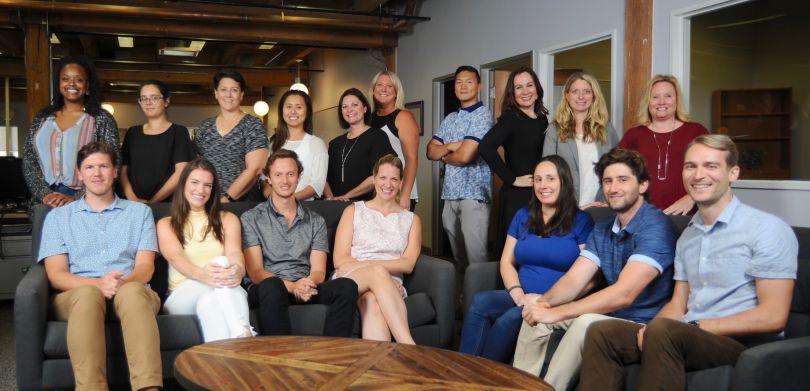If you’re unconvinced about the future of data’s involvement in literally any area of business, simply unlock your phone, navigate using Google Maps, take an Uber, order takeout or, well...you get the drift. Data is everywhere; not just within the confines of the company walls where teams are developing self-driving vehicles or sending people to space.
In part two of a two-part series on how tech teams are leveraging data, we spoke to seven additional companies about what the ability for direct personalization means for the future of their industries.

If you’ve ever screamed the phrase “speak to a rep-re-SEN-ta-tive” into the phone at an automated system, you know how broken many customer service processes truly are. Vail Systems is working to rectify those pain points so customer communication woes are a thing of the past. How are they doing it? With data, of course. We spoke to Chief Data Scientist Vijay Gurbani about detecting fraudulent callers and training artificial intelligence systems.
What’s one way your team uses data that people may not expect?
When dealing with huge amounts of call and voice data, it can be challenging to extract the right information. We do a lot of work in fraud detection and are constantly looking for innovative ways to thwart fraudulent callers. One way we detect fraudsters is by computing the average time it takes for a caller to authenticate themselves to the call center. If the authentication requires entering an account number/PIN, we can study the inter-digit utterance or keypress time and exploit the fact that legitimate callers know their account number/PIN and are able to authenticate a few milliseconds faster than fraudulent callers.
One way we detect fraudsters is by computing the average time it takes for a caller to authenticate themselves to the call center.’’
What’s a recent data-driven project your team worked on that created success for either the company or its customers?
When customers engage call centers, the interaction can be used successfully to train AI models to aid in fraud detection. For these models to be successful, the interaction transcript must be of high quality. Oftentimes, the software that creates the transcript has trouble understanding certain words. For example, it may transcribe “efficient” when it hears “deficient.” We recently explored novel approaches in ambiguity resolution for text mining that would remove such inefficiencies and improve the transcript quality by 60 percent. This results in better-trained models that can immediately aid our customers in their workflows.

PerkSpot allows employers to recognize their team with more than a pat on the back or “job well done,” using valuable consumer data. Senior Director of Partner Marketing Taylor Somach explains how customers can take advantage of recognition in the form of benefits ranging from home services to movie tickets, and why PerkSpot is currently laser-focused on optimizing their offers.
What’s one way your team uses data that people may not expect?
Our team is constantly evaluating customer interest and feedback in order to offer the best possible mix of discounts in emails to satisfy the employees we serve. This year, our team built an internal email scoring tool that uses past data and predictive analytics in order to optimize each email even further to drive user happiness. Oftentimes, it’s the merchants we least expect that users want to see more of. So data has allowed us to look past our biases and truly optimize our products.
Oftentimes, it’s the merchants we least expect that users want to see more of.’’
What's a recent data-driven project your team worked on that created success for either the company or its customers?
By analyzing user behavior and market trends, we’ve been able to work with merchants to deliver a higher level of complementary offers to employees before, during and after purchase. The goal is always to improve the quality and breadth of our discounts, and we’re able to deliver stronger results for all of our customers by making sure we get them the right offers at the right time. We’ve always had this data, but with our high-paced growth and the addition of results-driven coworkers to the PerkSpot team, our ability to get projects done efficiently and effectively has improved drastically.

Root takes data so seriously that an engineer on their team built a bot tasked with dissecting their lunch Slack channel interactions as a side project. Because, after all, data doesn’t only shape the way we work. It can tell us more than we ever wanted to know about how we eat, sleep and exercise (or don’t). Or, according to Scott Parker, Root’s director of engineering, how we drive.
When it comes to wanting a more complete view of a roadmap to driver safety, we don’t have to think twice.
What’s one way your team uses data that people may not expect?
Root lives on data. We rely upon it to power our products as well as our approach to building products. What’s more surprising is how our data-driven approach permeates our culture.
For example, our engineering teams periodically take “hack days” to learn new technologies or pursue passion projects. Recently, an engineer showcased their passion project, a Slack bot for our lunch menus. In their showcase, they went deep on our patterns of interacting with this bot and how that should drive future development. We don’t mandate data-driven decision making for hack days, but it’s a shining example of how central data is to even our side projects.
This is only possible because of data that wasn’t available even a few years ago.’’
What’s a recent data-driven project your team worked on that created success for either the company or its customers?
Root understands drivers through a “test drive” of driving behavior over a few days and a few miles. When we were founded, your phone was the best source of data about these driving habits.
Now, most new cars are connected cars. With your express permission, we can connect directly to your car’s data and understand your driving behavior from the source. This allows us to offer quotes almost instantly, still tailored to your driving. It’s a better experience and rewards you for the data that newer cars are already collecting. This is only possible because of data that wasn’t available even a few years ago.

Data alone won't detect and fix a potentially damaging machinery service problem. Engineers and product development specialists do that. Cat Digital Analytics Strategist Chris Ha told us how the combination of resourceful team members and access to meaningful statistics makes Caterpillar Inc. a force to be reckoned with.
What's one way your team uses data that people may not expect?
We love data and working with cutting-edge data science and deep learning tools. But sometimes, we have to solve customer challenges before we’ve had time to fully analyze our massive amounts of data. In these situations, we see a lot of value in relatively simple models that can provide meaningful insights. Sometimes, the simplest model is the best model because it enables us to extract and deliver value quickly. Our team uses our judgement and expertise to determine the best approach to each problem to make sure we’re delivering a competitive advantage for Caterpillar. Data is valuable. Data plus expertise is priceless!
Data plus expertise is priceless!’’
What's a recent data-driven project your team worked on that created success for either the company or its customers?
At Cat, we make some of the biggest trucks in the world (imagine a two story building, then add a few feet!). These machines operate around the clock in some of the toughest environments imaginable. We use telematics data in combination with advanced analytics to help our customers detect and localize small problems while they’re still small and before they turn into something more significant and costly.
When a customer is working at an isolated mining site and unplanned downtime can cost tens of thousands, or even hundreds of thousands, of dollars, Cat’s data-driven early warning systems are a game-changer. The customer can proactively service his or her machine, improving safety for the operator and minimizing operating costs.

Every successful event requires good food, quality content and, more recently, data based on industry standards. That’s exactly what Eved provides (the data, not the nachos). Manager of Client Solutions Enablement Katie Hayes told us how their benchmark assessment is a game-changer for client conversations as well as future meetings.
What’s a recent data-driven project your team worked on that created success for either the company or its customers (or both)?
Eved serves the meeting and event (M&E) industry. Although companies spend $840 billion annually on M&E, free educational resources for the professionals in this space are hard to come by. To fill this gap, we created the now annual benchmark assessment for meetings and events. The survey and subsequent comprehensive report we publish quantifies the tools and processes adopted by the M&E industry so companies can identify how others operate, how they compare and how they can advance their processes.
Providing a peer-based, data-led resource specifically for M&E has been highly effective in generating conversations and establishing trust within the industry.
We have the percentage breakdown of how major corporations perform every key back-end operation of our industry.’’
What’s one way your team uses data that people may not expect?
The benchmark survey and report fuels our team with up-to-date and relevant industry data throughout the year.
From the benchmark survey results, we have the percentage breakdown of how major corporations perform every key back-end operation of our industry. Having this data in our back pockets enables us to possess a completely different narrative when working with a prospect. Instead of just talking about the value of Eved’s software, we can empathize with a challenge a company is experiencing and provide the data on how other companies resolved that problem and how it affected their business. Our benchmark data enables our sales and customer teams to start much more productive, unbiased and educational conversations.

Confident that you just came up with your industry’s next best idea? Better confirm that it hasn’t already been copyrighted. Such action is just one example of intellectual property protection, and it matters a whole lot when trying to get a business concept off the ground. We recently spoke to John Wiora, COO of ktMINE, about how they incorporate data into the IP process, making a notoriously complicated to-do list item that much more accessible.
What’s one way your team uses data that people may not expect?
ktMINE is comprised of a diverse group of professionals, driven by the desire to continuously improve products for our customers. ktMINE’s ethos is “nothing is sacred,” meaning we search for a way to develop solutions for business challenges. We introduced intellectual property data as a source for hedge funds to identify alpha. Our data and custom access options along with value-added data processing and a technical support team enables the analysts to ingest IP data to inform their investment strategies. Historically, investment professionals have ignored IP data. Our education and data structure helps these firms analyze once-hidden insights.
Our education and data structure helps these firms analyze once-hidden insights.’’
What’s a recent data-driven project your team worked on that created success for either the company or its customers?
Recently, we’ve made a big push leveraging application programming interface (API) and data processing capabilities to build custom data files and widgets for our customers. The key is understanding and developing the best solutions defined by unique requirements. Some users want to integrate ktMINE data through i-frames for their internal customers to interact with live analytics. Other users want data sliced into smaller custom files to streamline research processes. With our in-house capabilities, we can create widgets, SaaS apps and custom data files and provide API access to create customer solutions.

At Affinitiv, vehicles aren’t the only thing in the space that’s driven. The company relies heavily on data so that their customers can provide their clients with marketing collateral that makes a dent. We recently spoke to Courtney Evans, vice president of product marketing, about how they segment their audiences as precisely as possible and where they see themselves further down the road.
What’s one way your team uses data that people may not expect?
Data is at the core of everything we do. With all of our customers — both original equipment manufacturers (OEM) and dealer levels — we base our marketing efforts on data. We also feed data back to help create efficiencies within the dealerships and give the OEMs further company insights.
How we analyze this data and use it is unique to the market in the last few years. Ten years ago, we based our communications on data that was given to us. Today, we are taking in many different forms of data, both first-party coming from the customer and third-party data to help support and segment out different audiences. This third-party data can help paint a fuller picture of the customer, with everything from life events, consumer habits, credit history or additional facts.
Think of it as a giant Excel page. The customer would be the rows and different data points would be the columns. By supplementing and adding in new data sources, we are able to add more columns and learn more about each customer as an individual. Our marketing efforts can become more geared towards the individual rather than a segment based on time and mileage or basic customer information.
Data is at the core of everything we do.’’
What’s a recent data-driven project your team worked on that created success for either the company or its customers?
We have focused a lot on consuming different data sources, merging it with the data we already have. We then use the collective data to create better segments and audiences for our marketing efforts. A great example of this is the work we do on prospecting clients. Our customers are constantly looking for new customers and how to supplement those lost. We have designed new audiences that are based on life events and consumer habits to create more specific groups of people who are likely to be in the market either for a new vehicle or servicing work.
By using the data collected from both first- and third-party sources, we are able to get more granular, create more audiences and properly convey the right message. This helps to bring new customers in and decreases our clients’ marketing spend. With those same audiences, we can vary the offers or messaging in one piece of marketing material to appeal more to the individual and their unique needs and habits to warrant better results.







